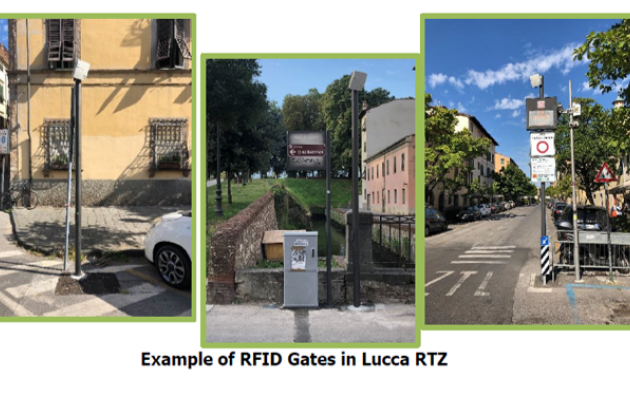Date of label : 29/10/2024
-
Lucca , Italy
-
Size of city : 90.000 inhabitants

Collage of three photos showcasing examples of RFID (Radio Frequency Identification) gates in Lucca's RTZ (Restricted Traffic Zone)
Summary
The practice in Lucca (IT) involved the implementation of a set of regulatory, organisational, operational and technological measures, related to the city’s logistics processes. In particular, the project team set up a “credit-based rewarding” policy for last mile deliveries, to promote sustainable freight distribution in urban areas. It aimed to help the city achieve higher standards of energy efficiency and urban air quality and, consequently, improve the quality-of-life of residents.
The solutions offered by the Good Practice
To promote sustainable freight distribution, the project developed and validated an innovative tool to manage flexible and differentiated “credit based” regulation and pricing criteria for last mile delivery. This used a Logistic Credit Management Platform (Locmap), which integrates the Restricted Traffic Zone (RTZ) access control system, dedicated to urban freight distribution processes in Lucca.
The credit system takes into account static parameters (a vehicle’s technical characteristics, mainly the type of engine/fuel and dimensions/weight) and dynamic parameters (the behavior of the operator).
In particular, three different technological solutions were put in place:
- 22 RTZ entry/exit gates with new RFID system to monitor operators access/exit in/from the RTZ (operators were supplied with a specific tag with the entry permit).
- 34 L/U parking lots, equipped with smart wireless sensors under the road surface.
- 3 cargo-bike stations with three cargo bikes each available for transport operators.
Building on the sustainable and integrated urban approach
The project took an integrated approach to tackle the environmental, economic and social aspects of urban challenges at the same time.
The implemented measures to reduce vehicular pressure in the historic city centre aimed to improve air quality, protect public squares and historical monuments from degradation due to pollution, and encourage the transition towards a greener logistics without harming local businesses.
To reduce traffic in the narrow streets of the centre, the project envisaged solutions with zero impact on the environment and without the risk of accidents, fines and traffic jams. By restricting access and parking for fuel-powered commercial vehicles, the initiative created safer streets with more space for pedestrians, and made the city centre more livable for residents and commuters, and more attractive to the thousands of tourists who visit every year.
Based on participatory approach
The project established groups to discuss the transport of goods, reducing pollution, and the socio-economic and environmental well-being of the historic centre:
- CTS (Scientific Technical Committee): 14 participants from regional and national bodies and associations.
- Permanent Logistic Roundtable: Freight transport operators deliving goods in the historic centre and the main trade associations.
CSSF (Cities and Stakeholders Supporting Forum): 12 stakeholders including public bodies, research agencies, and international supporters.
CTS and CSSF met at least once a year to assess progress and provide suggestions. The Roundtable, with mostly local stakeholders, met more frequently and in person, though moved online during the pandemic.
What difference has it made?
Aspire measures (Assessment, Planning, Implementation, Review and Evaluation) were obtained through monitoring activities by means of a specific set of indicators. Data was collected automatically using the Locmap platform, tracking vehicles’ access/exit and stay within the RTZ. The use of the loading/unloading stalls and the cargo bike sharing system were also monitored, the latter using a dedicated app. Socio-economic and environmental data came from the municipal offices, while air quality data was collected at an on-site monitoring station.
The results were analysed by comparing conditions before and after implementation, focusing on environment, mobility, liveability, and the safety of the historic centre. Although the municipality temporarily shut the gates during the 2020 lockdown, the results demonstrate a decline in logistics flows and a consequent reduction of CO2 in the historic centre. Full details of the expected and achieved results are included in the Final Report submitted to the Commission at the end of the project.
Why this Good Practice should be transferred to other cities
A strategy for replicating and transfering the approach was developed and published in a plan. This included actions to multiply the positive benefits of the measures, thus assuring a significant uptake of the innovative and sustainable solutions for last mile deliveries. The plan also took into account the experience of partner cities.
The strategy addresses not only "what" to transfer, but also "how" other European cities and towns can implement the Aspire approach. The measures implemented in Lucca to decarbonise logistics in the historic centre can be replicated by all cities with similar characteristics and policies for reducing CO2 emissions.
The project reflected local policies of sustainable mobility and improvement of air quality, which derive from specific national indications, but the approach can be adapted in other countries where there is a strong drive towards sustainabile mobility.
Lucca’s historic centre has a distinctive shape, defined by a medieval wall which facilitates the monitoring of vehicles at the entrance, though other cities can adopt other monitoring approaches. However, many other middle-sized cities can readily adopt measures such as dedicated parking stalls and cargo bike sharing systems.
To achieve the best results in the implementation of these measures it is necessary for all the stakeholders to share a common vision of sustainable mobility and a greener city, including logistics operators, shopkeepers and retailers, residents, trade associations, and politicians. Frequent consultation meetings are also important.
The good practice has been widely diseminated through study visits, events such as European Green Week 2021 and European Mobility Week 2021, various conferences, and publications.
